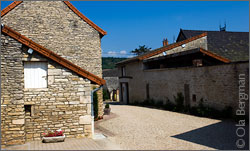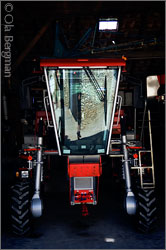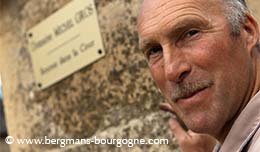
omaine Brelière is pure Rully. Jean-Claude and Anna Brelière run a seven hectare domaine at the top of the Côte Chalonnaise. All their wines are Rully wines. Both red and white. Both on village level and on premier cru level.
– My father refused to have any other appellation, Jean-Claude Brelière says jokingly. Quite a few of my colleagues have some Mercurey vines. There was a time when the Rully wines were difficult to sell and when it was easier to sell Mercurey. I would imagine that it was thanks to his crémant, that he had another product to sell, that my father didn't have to look for vineyards in Mercurey.
Rully is a small quiet village just ten minutes south of Chassagne-Montrachet, but despite being close to one of the finest white wine villages in the world this village has a very different situation. When the departments of France were created after the revolution Rully ended up in the Saône-et-Loire, the south-eastern department of the four that together make up Burgundy.

– When people talk about Burgundy they talk about the Côte de Nuits and the Côte de Beaune, says Jean-Claude Brelière. Chablis is another Burgundy on its own, well-known all over the world. We are so close to the Côte de Beaune, but we are transparent. Nobody sees us.
The annual production of Rully is roughly of the same size as Pommard. Two thirds of the production is white and there are a total of 23 premiers crus.
– We have the same soil as the Côte de Beaune. What we don't have is the name and the reputation.
Domaine Brelière dates back to 1948 when René Brelière, Jean-Claude's father, planted his first chardonnay vines in the premier cru of Les Margotés in the south-western part of the appellation. This was when Rully, after several troubled decades, slowly began to recover. In the late 19th century the phylloxera wiped out most of the vines and replanting did not really take off until after the two world wars.
– My father was one of the first to replant, explains Jean-Claude Brelière. They were a group of young winegrowers that really believed in the appellation. My father made his own crémant, something that he had learned from a producer of sparkling wines he had worked for.

– The competition was low back then. There were only a few selling wine in bottle, perhaps three or four. Now we are 15-17. Even when I came back to the domaine in 1983 there were just a few.
Initially Jean-Claude Brelière had other plans than becoming a winegrower in Rully. He did go to wine school, but when he was 19 he started toying with the idea of becoming an interpreter.
– I have always had a passion for foreign languages, he explains. I wanted to learn English, so I went to Australia. But that didn't work out, so I went to England instead. I had been working as a waiter, gaining enough experience to get a job in London, at the Great Eastern Hotel. I stayed there for two years, studying at the same time.
Then a year at junior college in the US followed, two years in Madrid, one year in Berlin and two years in Cologne.

– I then came back home and worked for Creusot-Loire as an interpreter for Iraqi engineers. After that I decided to go to Paris and I went back to working as a waiter. Later on I found work at the German automobile club, ADAC.
Then in 1983 his father asked him for the second time if he was interested in taking on the family business in Rully, a domaine that had grown to cover 15 hectares. His brother was not interested, so it was up to Jean-Claude if Domaine Brelière would continue to produce wine.
– It was a very difficult decision, says Jean-Claude Brelière. I had had it in mind ever since I left, that I one day might return. It was a decision that required time. Now my father was turning 60 and wanted to retire, so I had to come to a decision within a few months.
He decided to return to Rully. This also meant brushing up on his winemaking skills. A year at the lycée in Beaune was followed by another year in Dijon for a degree in oenology.
– That's how the passion for wine came back, he says. After so many years I had lost track. I didn't drink wine. I would drink milk, coca-cola and stuff like that. Of the 15 hectares my father had half of it was red and half of it white. Half of the domaine was rented to others, and that was my brother's part.

Since then much of the work has been focused on improving the quality. The winemaking is pretty much the same. It is in the vineyards that the big changes have been taking place.
– We have done a lot about quality, says Jean-Claude Brelière. In the early 1990's we decided to cut the yields. My father went mad, saying that you can't throw away what nature gives you. Nature will be generous one year and then damage everything the next. But if you think like that you will never improve, never go for quality.
The next step for Domaine Brelière was to abandon weed killers. Doing that means you will have to spend much more time out in the vineyards. Instead of going out once a year spraying Jean-Claude Brelière had to be out there much more often ploughing.
– Our plan is now to go organic from 2010. For the past three years we have been in contact with the people that will certify us.
– There was a period after the horse – my father had a horse – when the tractor and all those chemicals came. It was a period that lasted for 30-40 years when you as a winemaker wouldn't observe your vineyard. You would just spray and then leave. Now we spend much more time there. We green harvest, we plough and we observe.
– 95 percent of the work takes place in the vineyard. The quality of the grapes is what is important. This was forgotten during that period. The 1960's was when the oenologists came out of the universities and I can tell you it was like God on earth. Because they had the science and my parents did not. All of a sudden it was the oenologist making the wine, not the winemaker. It took a long time until it became like now, when the oenologist is a partner to the winemaker.
© 2009 Ola Bergman














